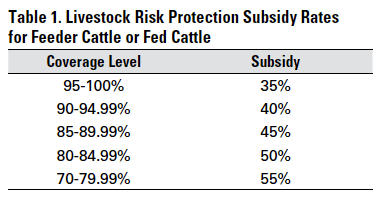Encourage Your Organization: Bagley Risk Management Insights
Encourage Your Organization: Bagley Risk Management Insights
Blog Article
Recognizing Livestock Risk Security (LRP) Insurance Coverage: A Comprehensive Overview
Navigating the realm of animals threat defense (LRP) insurance can be a complex undertaking for numerous in the farming market. This kind of insurance coverage offers a safeguard against market fluctuations and unanticipated conditions that could impact livestock producers. By recognizing the intricacies of LRP insurance coverage, manufacturers can make enlightened choices that might secure their operations from monetary threats. From exactly how LRP insurance functions to the different protection choices readily available, there is much to reveal in this extensive overview that can possibly form the way livestock manufacturers approach danger monitoring in their companies.

Exactly How LRP Insurance Coverage Works
Occasionally, recognizing the mechanics of Livestock Threat Security (LRP) insurance policy can be complex, but breaking down just how it works can provide clarity for farmers and breeders. LRP insurance policy is a threat management tool created to shield animals manufacturers versus unanticipated rate declines. It's important to note that LRP insurance is not an income guarantee; rather, it concentrates exclusively on cost risk defense.
Qualification and Insurance Coverage Options

When it comes to protection alternatives, LRP insurance offers producers the flexibility to pick the insurance coverage degree, insurance coverage duration, and recommendations that finest fit their risk administration requirements. By understanding the eligibility criteria and insurance coverage alternatives offered, livestock producers can make enlightened choices to handle risk effectively.
Benefits And Drawbacks of LRP Insurance Policy
When reviewing Animals Danger Protection (LRP) insurance, it is important for animals manufacturers to evaluate the benefits and negative aspects integral in this danger administration tool.

One of the key benefits of LRP insurance is its ability to offer security versus a decrease in animals costs. In addition, LRP insurance policy supplies a degree of adaptability, permitting manufacturers to tailor insurance coverage degrees and plan periods to fit their certain requirements.
One constraint of LRP insurance coverage is that it does not protect versus all types of threats, such as illness outbreaks or all-natural disasters. It is crucial for manufacturers to very carefully evaluate their specific risk direct exposure and monetary situation to determine if LRP insurance policy is the ideal danger administration device for their operation.
Understanding LRP Insurance Premiums

Tips for Optimizing LRP Benefits
Taking full advantage of the advantages of Livestock Danger Defense (LRP) insurance calls for strategic preparation and proactive risk monitoring - Bagley Risk Management. To make the most of your LRP coverage, think about the complying with pointers:
Frequently Examine Market Problems: Keep informed about market trends and cost changes in the animals market. By keeping an eye on these variables, you can make enlightened decisions about when to purchase LRP coverage to protect against potential losses.
Set Realistic Coverage Degrees: When picking insurance coverage degrees, consider your manufacturing prices, market worth of animals, and possible threats - Bagley Risk Management. Establishing sensible insurance coverage degrees ensures that you are effectively shielded without paying too much for unneeded insurance
Diversify Your Insurance Coverage: Rather than counting entirely on LRP insurance, think about expanding your danger monitoring approaches. Integrating LRP with other threat administration devices such as futures agreements or alternatives can supply comprehensive coverage versus market uncertainties.
Review and Readjust Protection Consistently: As market problems change, periodically assess your LRP protection to ensure it straightens with your present danger exposure. Readjusting insurance coverage levels and timing of purchases can help optimize your risk protection strategy. By following these ideas, you can make the most of the benefits of LRP insurance coverage and protect your animals procedure against unpredicted dangers.
Verdict
Finally, livestock danger protection (LRP) insurance coverage is a valuable tool for farmers to take care of the financial dangers related to their livestock procedures. By comprehending just how LRP works, qualification and coverage options, along with the pros and disadvantages of this insurance policy, farmers can make educated decisions to secure their source of incomes. By meticulously considering LRP premiums and carrying out methods to take full advantage of benefits, farmers can reduce prospective losses and ensure the sustainability of their procedures.
Animals manufacturers interested in obtaining Livestock Risk Security (LRP) insurance coverage can discover an array of qualification standards and coverage options tailored to their specific livestock operations.When it comes to coverage options, LRP insurance coverage supplies manufacturers the flexibility to select the coverage degree, insurance coverage duration, and endorsements that ideal suit their danger management demands.To understand the intricacies of Livestock Risk Defense (LRP) insurance policy totally, comprehending the aspects influencing LRP insurance policy premiums is important. LRP insurance coverage premiums are figured out by various elements, consisting of the insurance coverage degree selected, the expected rate of animals at the end of the protection period, the kind of animals being insured, and the length of the insurance coverage period.Review and Readjust Protection Consistently: As Read Full Article market problems change, occasionally assess your that site LRP protection to ensure it straightens with your present danger exposure.
Report this page